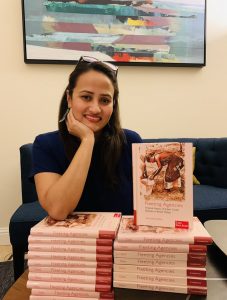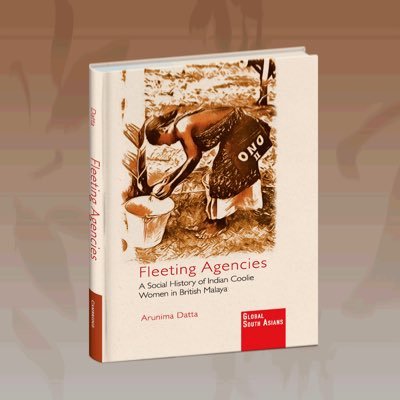Q&A with Dr Arunima Datta on ‘Fleeting Agencies: A social history of Indian Coolie women in British Malaya’
Asst Professor Arunima Datta’s (Idaho State University) recent book takes readers on a journey into the lives of coolie women who left British South India for British Malaya from the late 1800s – early 1900s to labour in the empire’s rubber plantations.
Fleeting Agencies is an important ground-up history and critical interrogation of the impacts of structural violence cultivated under colonialism. Dr Datta’s scholarship foregrounds the extraordinary courage and agency of coolie women, men and families who sought to improve their situations away from home and create better lives for themselves and those around them.
Q: Your nuanced idea of ‘fleeting agencies’ stresses the strategic and circumstantial. Tell us more.
The central argument of Fleeting Agencies is that coolie women played crucial roles in the rubber plantations of Malaya as producers and reproducers of labour, and that despite being exploited, oppressed, and used by more powerful actors, including colonial planters and administrators, middle-class Indian nationalists, and their own husbands or sexual partners, they did not consent to be passive victims but exercised agency in navigating the complex dilemmas of plantation life in protean ways ranging from strategic compliance to armed resistance.
Fleeting Agencies, thus, highlights the artistry and creativity of coolie women in negotiating with various hierarchies and power structures, unveiling the ways they actively engaged with the contexts they found themselves in and deployed different modes of agency that they understood to be appropriate to particular situations.
Fleeting Agencies shows how individuals in oppressed situations often vacillated between agent and victim identities and at times even experienced both simultaneously. Such brief and episodic moments of agency, without transformative goals, can be best described as situational agency, wherein individuals use their agency to escape victimhood, even if only temporarily, with varying degrees of success.
Such agencies were reflected in individual situational choices and in actions to negate the power of others over them for a brief period. Importantly, although agencies were fleeting, episodic, and often motivated by short-term aims, they had significant long-term economic and political consequences for the modern postcolonial nations of Malaysia and India even if that was not their primary aim at the time.
The term ‘situational agency’, thus, captures the coexistence of traits of complicity, resistance, and ‘survivance’ within an individual’s agential act. So, whilst the issues raised in this book are rooted within the late nineteenth and early twentieth centuries, they have contemporary social and political relevance.
Q: How did you get drawn into the worlds of coolie women?
Being a South Asian Migrant in various parts of the world since a child, I was always drawn towards the history of South Asian migration. My interest in the history of coolie women developed during my MA when I was deeply disturbed by the silences in the scholarships about South Asian women and their contribution to transnational networks and colonial economy, particularly in Southeast Asia. They were constantly figuring in census, ship manifests and in labour department records but they remained forgotten in scholarly works. This unsettling silence drew me to investigate their histories.
Q: How do your archival and interview research findings advance narratives of migration and nation-building?
Any transnational history is very difficult as most sources are scattered across various departmental files and various geographical spaces. I had to explore archives in the US, UK, India, Singapore, and Malaysia before I could write this book. It was very challenging, but also rewarding. The very nature of archival availability for this research shows that the coolie women were important to the lands they migrated to and from.
Today the words ‘migration’ and ‘diaspora’ have become problematic words which not all migrants want to attach themselves with mainly because of the lack of belonging these words have been attached to. In such contexts, studies like Fleeting Agencies helps us understand the value these women had for both India and Malaysia and how much they belong and rightfully have a place in Malaysian society and history.
It is also a hope that more studies like this are taken up by scholars to allow us to appreciate the webs of connections between different regions of Asia that these subaltern subjects help us visualise.
Q: How do you reconcile intentions for neutral use of the term ‘coolie’ versus the discomforts experienced by those (including descendants of coolies) who prefer using the term ‘rubber-estate-workers’?
The social stereotypes, prejudices, and presumptions surrounding the term ‘coolie’ gave me additional themes and textures to work with in this study. ‘Coolie’ does not have any given (positive or negative) meaning attached to it; rather it is the economic, political, social, and racial concerns that influenced the evolution of derogatory ideas about ‘coolies’.
There are various claims regarding the origins of the term. The most commonly heard, at least in Malayan history, is that it derives from the Tamil word ‘kuliah’, which refers to a person of low caste who performs menial and hard physical labour.
Most rubber-estate coolies in colonial Malaya were Tamils, and in this study, whenever the term ‘coolie’” is mentioned, it refers to Indian Tamil coolies, both men and women, unless otherwise indicated. I use the term consciously but in a non-derogatory manner to refer to the professional category that is the subject of this book. I understand that using the term as a professional category, as archival records suggest, is contentious since the term in the present day carries a heavy derogatory baggage.
But the chapters in this study unpack some of the prejudices attached to the term, showing how such conceptions resulted from social constructs used both in the past and the present to (re)inscribe power, racial, and class hierarchies. Using the term to describe the professional category, Fleeting Agencies thus suggests a (re)visioning of the term and a restoration of the term to working-class people, some of whom still identify with it.
In my interviews with Indian ex-coolies and descendants of Indian coolies in present-day Malaysia, I came to understand that the surviving coolie women and men often distanced themselves from the term as a result of contemporary connotations of racial and class identity. Nonetheless, few individuals continue to identify as former ‘coolies’ or their descendants. For them, the term had nostalgic connotations, and they took some pride in the fact that they or their ancestors were part of the ‘coolie army’ that built modern Malaysia.
When I asked whether the term offended them, some explained that it did when used to disrespect their profession or their community. During the conversations, they claimed that they were proud of their coolie connection and for them the term meant hardworking labourers who were self-made men and women. Using the term ‘coolie’ to include both women and men, this study thus not only democratises its scope on the grounds of gender, but also acknowledges the contributions of individuals, particularly women, who made the rubber empire of Malaya. Fleeting Agencies thus seeks to respect and celebrate the rich history of South Asian labourers in the country.

Q: Emphasising intersectional agencies under extremely oppressive circumstances can be seen as counter-intuitive, even radically hopeful. How did you read and write against the grain?
In all these cases, it was very evident that the women were voicing their rights and choices, but were frequently being dismissed. Those in power actively muted and withheld the voice of these women. However, pictures, census reports, newspapers, and oral history archives allowed me to understand the coolie women’s muted voices.
The temporality of the visibility of the coolie women’s voices, or their escape from victimhood does not discount the fact that they chose to act despite the risks. Fleeting Agencies shows how individuals in oppressed situations often vacillated between agent and victim identities and at times even experienced both simultaneously.
Such brief and episodic moments of agency, without transformative goals, can be best described as situational agency, wherein individuals use their agency to escape victimhood, even if only temporarily, with varying degrees of success.
Q: Given the scholarly silences with respect to many marginalised groups, what are your tips to other feminist historians for such work to remain a resilient practice?
While most of the documents in the archives are full of silences, there remains muted voices that fleetingly appear to us. Look for those voices, however muted they are and never fear silences. We can ask questions about how and why certain silences are there which often lead us to discovering lesser-known histories. As Anjali Arondekar says, ‘An empty archive can also be full.’
Q: Was there anything surprising which you edited out of the book?
Yes, the story of Indian ayahs who served the coolie women by taking care of their children. It appears fleetingly in my book. But I found sometimes these ayahs were employed by the planters who travelled back to Britain with them. These women became known as ‘travelling ayahs and amahs.’ My second book focuses on the history of these incredible women who at times travelled up to 50 times between Asia and Britain while serving colonial families.
Q: How best can we incorporate material from your book into the various courses we teach?
I believe various chapters of this book can be used independently as course readings for upper division UG and Graduate classes, which focus on feminist histories, subaltern histories, women migration histories, histories of the Empire, labour histories, Inter-Asia history and many more. But also the book as a whole can be used as textbooks for classes that focus on Global South Asian histories. In fact, I know professors in Harvard, Yale, University of Texas Austin, Nanyang Technological University and Singapore University of Technology and Design are already using my book in their courses.
Chapters on the coolie women’s work can easily be adopted in courses focused on labour and women migrations to understand how women in colonial plantation contexts were conscious of their importance as labour producers and reproducers.
Chapters on domesticity and intimacies can be adopted in gender studies and Empire classes to explore the colonial influence on our understanding of certain terms like ‘domesticity’, ‘morality’, ‘domestic violence’, ‘violence’, and develop more nuanced understanding of the terms.
Chapters on the coolie women’s involvement in transnational nationalist movements can serve as a crucial reading for not only courses focused on gender, war and nationalism, but also for understanding Asian transnational nationalisms.
The views expressed in this forum are those of the individual authors and do not represent the views of the Asia Research Institute, National University of Singapore, or the institutions to which the authors are attached.








